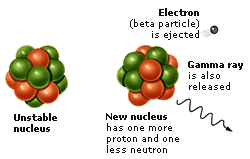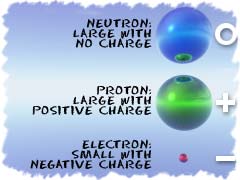Hello! Welcome back!
I know you must be very psyched to be reading this again! :) Anyway, this term's subject is still Chemistry, and the topic is Atoms. So now you must wondering what has the Periodic Table got to do with Atoms? Well, atoms have chemical symbols in them, and the Periodic table shows the Chemical symbols (Elements) and the number of protons, electron, and neutrons, which is needed to find out about the atoms. (refer to the previous previous post to read it again!)
Does it answer your question?
But, that is not the main topic for this post! The main topic is called Transition Metals.
#1
Transition Metals are located in groups IB to VIIIB.
As the possess the properties of metals, the transition elements are also known as the Transition metals.
What makes them so special is that they are able to put more than eight electrons in the shell that is one in from the outermost shell. In other words, this is the point in the periodic table where you can place more than 8 electrons in a shell.
Another point is that these metals are really very hard, with super high melting points, and boiling points.
The transition metals are able to put up to 32 electrons in their second to last shell.
Something like gold (Au) has an organization of 2-8-18-32-18-1.
Of course, there are still some rules. No shell can have more than 32 electrons. It's usually 18 or 32 for the maximum number of electrons.
Transition metals can use the two outermost shells/orbitals to bond with other elements.
It's a chemical trait that allows them to bond with many elements in a variety of shapes.
Example: Molybdenum (Mo) with 42 electrons. The configuration is 2-8-18-13-1.
It is therefore unstable. Those two orbitals (13 and 1) can use the electrons to bond with other atoms.
So what are it's uses?
Alloys
Transition metals are commonly used to create alloys, which are combinations of metals and/or non-metallic substances.
Many well-known substances are alloys made of transition metals.
Iron is combined with carbon and a variety of other substances to make steel, and the inclusion of chromium makes it stainless steel.
Copper makes up several well-known alloys: it is mixed with zinc to create brass, combined with tin to form bronze and mixed with nickel to form cupro-nickel, which is often made into coins.
Catalysts
Some transition metals and compounds of transition metals are used as catalysts in chemical reactions to speed up the rate of reaction without adding any reactive properties themselves.
For example, vegetable oils are turned into saturated fats that take longer to melt by way of hydrogenation.
Nickel is used as the catalyst so that hydrogen can effectively join a carbon-carbon double bond.
Saturday, July 17, 2010
Sunday, July 11, 2010
HYDROGEN BOMB! BOOMZ!
Scary huh? I mean does it sound scary?
Let me scare you with some pictures first! MUSHROOM!
The hydrogen bomb functions by the fusion, or joining together, of the lighter elements into heavier elements.
The end product again weighs less than its components.
Extremely high temperatures are required in order to initiate fusion reactions.
The hydrogen bomb is also known as a thermonuclear bomb.
The first thermonuclear bomb was exploded in 1952 at Enewetak by the United States, the second in 1953 by Russia (then the USSR). Great Britain, France, and China have also exploded thermonuclear bombs.
Structure of the bomb. Easy, but super dangerous.
Process of it.
Like other types of nuclear explosion, the explosion of a hydrogen bomb creates an extremely hot zone near its center.
In this zone, because of the high temperature, nearly all of the matter present is vaporized to form a gas at extremely high pressure.
A sudden overpressure, i.e., a pressure far in excess of atmospheric pressure, propagates away from the center of the explosion as a shock wave, decreasing in strength as it travels.
It is this wave, containing most of the energy released, that is responsible for the major part of the destructive mechanical effects of a nuclear explosion.
The details of shock wave propagation and its effects vary depending on whether the burst is in the air, underwater, or underground.
Let me scare you with some pictures first! MUSHROOM!
The hydrogen bomb functions by the fusion, or joining together, of the lighter elements into heavier elements.
The end product again weighs less than its components.
Extremely high temperatures are required in order to initiate fusion reactions.
The hydrogen bomb is also known as a thermonuclear bomb.
The first thermonuclear bomb was exploded in 1952 at Enewetak by the United States, the second in 1953 by Russia (then the USSR). Great Britain, France, and China have also exploded thermonuclear bombs.
Structure of the bomb. Easy, but super dangerous.
Process of it.
Like other types of nuclear explosion, the explosion of a hydrogen bomb creates an extremely hot zone near its center.
In this zone, because of the high temperature, nearly all of the matter present is vaporized to form a gas at extremely high pressure.
A sudden overpressure, i.e., a pressure far in excess of atmospheric pressure, propagates away from the center of the explosion as a shock wave, decreasing in strength as it travels.
It is this wave, containing most of the energy released, that is responsible for the major part of the destructive mechanical effects of a nuclear explosion.
The details of shock wave propagation and its effects vary depending on whether the burst is in the air, underwater, or underground.
Orbital theory...Sounds so Chim!
Well, this was supposed to be called the Molecular Orbital Theory, or MO Theory.
The goal of molecular orbital theory is to describe molecules in a similar way to how we describe atoms, that is, in terms of orbitals, orbital diagrams, and electron configurations.
Humph, I wonder how it will be done...
Orbital diagrams are usually drawn to make things easier to understand. :D
O2
O
These 2 pictures are actually diagrams for O2 and O. They are oxygen! :p
Each line in the molecular orbital diagram represents a molecular orbital, which is the volume within which a high percentage of the negative charge generated by the electron is found.
-The molecular orbitals are filled in a way that yields the lowest potential energy for the molecule.
-The maximum number of electrons in each molecular orbital is two.
-Orbitals of equal energy are half filled with parallel spin before they begin to pair up.
It can usually be found in this equation:
Isotopes!
Welcome back to the next series of Atoms! I really hoped you had fun in reading the previous post! Anyway, due to time constrain, I have fast forward the lesson to Isotopes!
So what exactly are Isotopes???? Hmmm...
Atoms of the same element can have different numbers of neutrons; the different possible versions of each element are called isotopes.
Refer to the previous post to recap on what is Neutron! :)
Hydrogen
The most common isotope of hydrogen has no neutrons at all; there's also a hydrogen isotope called deuterium, with one neutron, and another, tritium, with two neutrons.
You might now wonder how many Isotopes can 1 element have.
Well, sad to say that an atom cannot just have any number of neutrons. There are combinations of neutrons and protons, at which the forces holding nuclei together seem to balance best. Atoms with a few too many neutrons, or not quite enough, can sometimes exist for a while, but they're unstable.
So what is unstable in the above question?
Unstable atoms are radioactive: their nuclei change or decay by spitting out radiation, in the form of particles or electromagnetic waves.
Radioisotopes/ Radioactive Isotopes
That question above ^^^^^ leads me to the next topic, called radioisotopes!
It is well, sad to say that Radioisotopes are really really really (I mean really) dangerous.!!!
Because the like charges of the protons repel each other,there are always forces trying to push the atom nucleus apart. The nucleus is held together by something called the binding energy.
In most cases, elements like to have an equal number of protons and neutrons because this makes them the most stable. Stable atoms have a binding energy that is strong enough to hold the protons and neutrons together.
Even if an atom has an additional neutron or two it may remain stable. However, an additional neutron or two may upset the binding energy and cause the atom to become unstable.
In an unstable atom, the nucleus changes by giving off a neutron to get back to a balanced state. As the unstable nucleus changes, it gives off radiation and is said to be radioactive.
I'm sorry to say that the picture isn't clear, but I can tell you that it is giving out radioactive waves...Reminds me of the Bombing at Nagasaki. 0-0
Other facts
You'll get why I am showing you the Table :)
All elements with atomic numbers greater than 83 are radioisotopes meaning that these elements have unstable nuclei and are radioactive.
Elements with atomic numbers of 83 and less, have isotopes (stable nucleus) and most have at least one radioisotope (unstable nucleus).
As a radioisotope tries to stabilize, it may transform into a new element in a process called transmutation.
Uses of Radioisotopes
Shocking?!?!?! Yes, it can be used in medication you know! -Feign shock-
One major use of radioisotopes is in nuclear medicine. Of the 30 million people who are hospitalized each year in the United States, 1/3 are treated with nuclear medicine.
There are nearly one hundred radioisotopes whose beta and/or gamma radiation is used in diagnosis, therapy, or investigations in nuclear medicine. The most used radioisotopes were discovered before World War II.
So what exactly are Isotopes???? Hmmm...
Atoms of the same element can have different numbers of neutrons; the different possible versions of each element are called isotopes.
Refer to the previous post to recap on what is Neutron! :)
Hydrogen
The most common isotope of hydrogen has no neutrons at all; there's also a hydrogen isotope called deuterium, with one neutron, and another, tritium, with two neutrons.
You might now wonder how many Isotopes can 1 element have.
Well, sad to say that an atom cannot just have any number of neutrons. There are combinations of neutrons and protons, at which the forces holding nuclei together seem to balance best. Atoms with a few too many neutrons, or not quite enough, can sometimes exist for a while, but they're unstable.
So what is unstable in the above question?
Unstable atoms are radioactive: their nuclei change or decay by spitting out radiation, in the form of particles or electromagnetic waves.
Radioisotopes/ Radioactive Isotopes
That question above ^^^^^ leads me to the next topic, called radioisotopes!
It is well, sad to say that Radioisotopes are really really really (I mean really) dangerous.!!!
Because the like charges of the protons repel each other,there are always forces trying to push the atom nucleus apart. The nucleus is held together by something called the binding energy.
In most cases, elements like to have an equal number of protons and neutrons because this makes them the most stable. Stable atoms have a binding energy that is strong enough to hold the protons and neutrons together.
Even if an atom has an additional neutron or two it may remain stable. However, an additional neutron or two may upset the binding energy and cause the atom to become unstable.
In an unstable atom, the nucleus changes by giving off a neutron to get back to a balanced state. As the unstable nucleus changes, it gives off radiation and is said to be radioactive.
I'm sorry to say that the picture isn't clear, but I can tell you that it is giving out radioactive waves...Reminds me of the Bombing at Nagasaki. 0-0
Other facts
You'll get why I am showing you the Table :)
All elements with atomic numbers greater than 83 are radioisotopes meaning that these elements have unstable nuclei and are radioactive.
Elements with atomic numbers of 83 and less, have isotopes (stable nucleus) and most have at least one radioisotope (unstable nucleus).
As a radioisotope tries to stabilize, it may transform into a new element in a process called transmutation.
Uses of Radioisotopes
Shocking?!?!?! Yes, it can be used in medication you know! -Feign shock-
One major use of radioisotopes is in nuclear medicine. Of the 30 million people who are hospitalized each year in the United States, 1/3 are treated with nuclear medicine.
There are nearly one hundred radioisotopes whose beta and/or gamma radiation is used in diagnosis, therapy, or investigations in nuclear medicine. The most used radioisotopes were discovered before World War II.
Chemistry.....Atoms!
Wasssssssssssssup People! It's officially chemistry for this term! One last term before the EOYs! But anyway, I'm here to tell you more about atoms, and not here to make you depressed by telling you that the next term is the EOYs.
So anyway, let me give you a brief overview of the whole topic on Atoms...I guess. :)
So I'm sure you will ask, what are Atoms?
Before I start on anything official here, please do read up on elements. It will help you greatly in the first part, which is now. :)
All elements are made up of Atoms.
This picture below shows what scientists have found, the shape I mean.
The picture above shows the interior of an atom. Fasinating isn't it?
You might be wondering what are the headings there, and it's quite easy to understand actually.
The nucleus of an atoms consists of Protons, and Neutrons. Protons are POSITIVELY CHARGED, while Neutrons are NEUTRAL.
Electrons are the small little particles orbiting the nucleus. They are NEGATIVELY CHARGRED.
The picture below might actually help you! :)
However, if you have taken a good look at the periodic table, you are able to see that there are over a HUNDRED elements. And each element has a different number of neutrons, protons, and electrons.
Now, how do you know which number is the proton number (atomic number), and which is the mass number (made up of protons, and neutrons)?
So let me tell you again, if you didn't quite understand what I was talking about.
Mass Number
-Usually at the top left hand of the element box (right in this case)
-Made up of Protons, and Neutrons
Atomic Number
-Usually at the bottom left of the element box (right in this case)
-Number of Protons
Facts
You might have noticed that although it is the same element, the mass number is different, but it's not any typo error. There is a scientific explanation behind it. The element here is Carbon. In this case, carbon is in different proportions, and that is why the mass number is different, but it is still carbon in any case.
So anyway, let me give you a brief overview of the whole topic on Atoms...I guess. :)
So I'm sure you will ask, what are Atoms?
Before I start on anything official here, please do read up on elements. It will help you greatly in the first part, which is now. :)
All elements are made up of Atoms.
This picture below shows what scientists have found, the shape I mean.
The picture above shows the interior of an atom. Fasinating isn't it?
You might be wondering what are the headings there, and it's quite easy to understand actually.
The nucleus of an atoms consists of Protons, and Neutrons. Protons are POSITIVELY CHARGED, while Neutrons are NEUTRAL.
Electrons are the small little particles orbiting the nucleus. They are NEGATIVELY CHARGRED.
The picture below might actually help you! :)
However, if you have taken a good look at the periodic table, you are able to see that there are over a HUNDRED elements. And each element has a different number of neutrons, protons, and electrons.
Now, how do you know which number is the proton number (atomic number), and which is the mass number (made up of protons, and neutrons)?
Mass Number
-Usually at the top left hand of the element box (right in this case)
-Made up of Protons, and Neutrons
Atomic Number
-Usually at the bottom left of the element box (right in this case)
-Number of Protons
Facts
You might have noticed that although it is the same element, the mass number is different, but it's not any typo error. There is a scientific explanation behind it. The element here is Carbon. In this case, carbon is in different proportions, and that is why the mass number is different, but it is still carbon in any case.
Subscribe to:
Posts (Atom)















